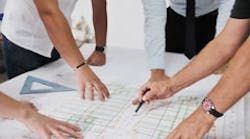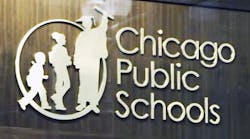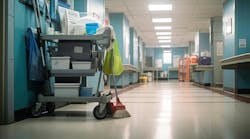The promise of sustainably designed school facilities is that they will operate more efficiently and last longer than buildings constructed in more traditional ways. But that promise comes with a big if. The payoff is delivered only if the facility managers operate and maintain the buildings in ways that adhere to sustainable strategies called for in the design.
Unfortunately, providing an appropriate level of maintenance is a goal that many schools and universities have failed to achieve. Even when education institutions have adequate budgets, they often skimp on maintenance spending and allocate funds to programs more directly connected with student learning. When spending is being slashed, as it has at many schools and universities in recent years, the temptation to succumb to shortsighted thinking and let maintenance slide may be too powerful to overcome.
The result is a massive deferral of maintenance needs at U.S. schools and universities. The estimate of the backlog ranges from $270 billion to more than $500 billion, according to the 21st Century School Fund, which advocates for improving public school facilities.
"Chronic deferred maintenance and repair can lead to energy inefficiencies, unsafe drinking water, water damage and moldy environments, poor air quality, inadequate fire alarms and fire safety, compromised building security and structural dangers," the Fund says.
So when a new or renovated school facility receives a LEED certification or comparable recognition for incorporating sustainable strategies into the design and construction, it is not so much a measure of what the building is, but an indication of what it can be. A good maintenance program will enable a sustainable design to deliver on its promises.
"Without effective maintenance and operations, many of the benefits (of high-performance schools) can be lost or eroded over time," warns the Collaborative for High-Performance Schools (CHPS) Best Practices Manual
Make a plan
Establishing an effective maintenance program will help most facilities operate efficiently and last longer. For buildings designed to be sustainable, such a program is especially important because the payoffs—in better energy efficiency, lower operating costs and longer-lasting facilities—are likely to be greater.
Before deciding the specifics of a maintenance plan, an education institution can set a strong foundation for a program by winning the support of various constituencies for pursuing sustainable strategies.
"There are many reasons to green an existing school," says the U.S. Green Building Council’s Green Existing Schools Project Management Guide, "including the health and achievement of students, teachers, and staff; improving a school’s energy efficiency, which in turn generates cost savings; and reducing the school’s environmental footprint."
The guide encourages schools to form a working group with representatives of the various departments, such as including facilities management, custodial and procurement staffs, administration, and finance that will be involved in carrying out green strategies. Programs to train staff members about carrying out sustainable building strategies will help ensure that improvements foreseen in planning are being carried out.
Building data
To operate and maintain a sustainable school facility effectively, workers should strive to carry out preventive maintenance steps on a regular schedule so that more serious and sudden system breakdowns don’t occur. Schools should create a maintenance plan that starts with collection of accurate data about a facility and its systems. The CHPS Best Practices Manual states that inspecting the various aspects of a facility to assess the building’s condition and tracking when repairs and upgrades have been made will give education institutions a basis for determining the amount of maintenance required.
That includes data such as the types of roofs, when they were installed, or the kinds of lighting installed and when they are due for replacement; or the various steps that workers should follow in periodic cleaning and maintenance of a building’s heating and cooling systems. A track record of the inspections carried out on various building elements will provide facility managers with evidence to convince school officials that maintenance is needed and beneficial.
"A proper inspection program is an important aspect of maintenance and can identify problems before they impact energy use and affect occupants’ health," the manual says. "Effective building maintenance requires regular inspections, cleaning, and detection of problems such as water penetration, structural damage or insect infestation."
To verify that a school facility is continuing to operate in an environmentally friendly way and provide the energy savings envisioned when it was designed, education institutions should consider commissioning or, when upgrades and repairs are carried out, recommissioning.
"If the school has been commissioned in the past and has faced either increased energy use or occupant complaints, it is likely the time to recommission the school," the CHPS manual states. "The goal of recommissioning is to return the school to its previously commissioned state, which includes turning and adjusting equipment, optimizing equipment operation and identifying equipment that needs repair or replacement."
Kennedy, staff writer, can be reached at [email protected].



